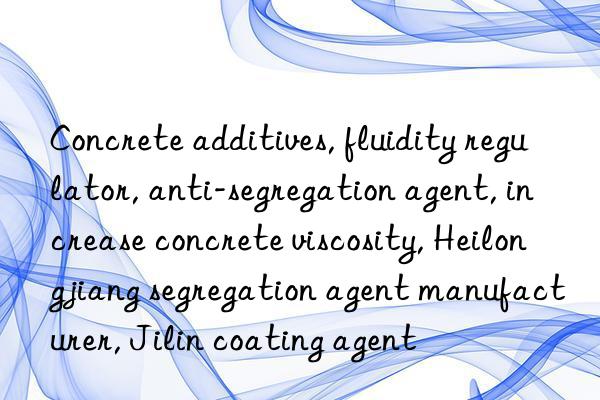
Anhui Yulong New Material Technology Co., Ltd. independently develops concrete anti-segregation agents. Its main function is to effectively reduce the high sensitivity of polycarboxylate water-reducing agent dosage, adjust and optimize the workability of concrete, and thereby prevent and avoid pipe blockage caused by segregation and bleeding of concrete during pumping construction of high-rise buildings. the occurrence of disadvantages.
Concrete additive fluidity regulator, anti-segregation agent, improves concrete viscosity
This article classifies the types of concrete cracks according to the causes, shapes, and crack development states. A detailed analysis was conducted and measures to prevent concrete cracks were proposed, hoping to provide assistance in preventing concrete cracks in construction projects in my country.
1 Classification of concrete cracks
Concrete is one of the necessities of construction projects and is crucial to construction projects Importantly, concrete is not a separate substance, but a substance made of cement, aggregates and additives mixed with water. After solidification, it has a strong hardness. During construction, concrete is generally poured on the steel frame. The appearance allows the concrete and steel to cooperate with each other to improve the overall quality of the building. However, during construction, due to various reasons, cracks may occur in the poured concrete, and the cracks may be large or small. This requires relevant staff to strengthen project review and handle concrete cracks in a timely manner to prevent potential safety hazards.
Because the causes of concrete cracks are different, they must be clearly classified.
1.1 Classification according to the cause of cracks
If concrete cracks are classified according to their causes, they can be divided into structural Cracks and non-structural cracks. Structural cracks are caused by the weak structural foundation of the construction project and the higher floors, which generate stronger stresses, leading to institutional cracks. The causes of non-structural cracks are more complicated, mainly due to external reasons. Because the building floors are high, several strong structural buildings need to be built on each floor to share the stress on the floor, reduce the load, and improve stability. However, the concrete wrapped around the structural building may be affected by temperature, humidity, Deformation occurs due to foundation settlement and other reasons, resulting in uneven stress distribution, causing cracks in the concrete wrapping the structural building. This type of crack is also called a deformation crack. According to surveys, most non-structural concrete cracks are caused by the lack of detailed inspections after construction and irregular maintenance of floors.
1.2 Classification according to the shape of cracks
my country has a long history of construction, and there are many problems with concrete cracks Experience, according to research, concrete cracks have various shapes. Common concrete cracks include longitudinal cracks, transverse cracks and X-shaped cracks. First of all, the steel bars on the building floors are mainly longitudinal and transverse. The longitudinal steel bars are subject to greater pressure loads, and after long-term external force erosion of the building, cracks parallel to the steel bars will appear, usually in the outermost layer of the building. This type of Concrete cracks account for the main types of concrete cracks; secondly, the distribution of transverse concrete cracks is opposite to that of longitudinal cracks. Transverse concrete cracks mainly appear in transverse concrete. Such cracks generally exist inside the building and are more affected by natural causes. Low, mainly due to higher or lower temperatures or larger loads, generally appearing on relatively low floors; Thirdly, X-shaped cracks appear less frequently, generally appearing in places that have been hit or experienced severe impacts. In buildings with higher earthquake levels, X-shaped cracks will appear along with problems in the concrete structure, such as beams, columns, etc. In addition to these three more common shapes of cracks, there are other relatively rare concrete cracks, such as figure-eight, radioactive, etc. The causes include natural causes, construction reasons, or other reasons.
1.3 Classification according to the development status of cracks
Concrete cracks can also be divided according to their development status , mainly divided into healable cracks, stable movement cracks and unstable cracks. Among them, the meaning of healable cracks is relatively simple. Such cracks will heal on their own due to various reasons and do not require manual technical repair. Stable motion cracks are the opposite of unstable cracks. Stable motion cracks will gradually self-heal for a period of time after the cracks appear due to various reasons. After healing, cracks will still appear and then heal again, forming a periodic cycle. Due to the reasons for their formation, cracks will not cause large-scale damage to the building; however, unstable cracks will pose a greater threat to the overall quality of the building. After the cracks are formed, they will continue to expand and degrade the building. According to research, the damage caused by unstable cracks to buildings is greater than the sum of the damage caused by healable cracks and stable moving cracks.
<img src="/upfile/202304/2023041334528065.jpg"/


 微信扫一扫打赏
微信扫一扫打赏
